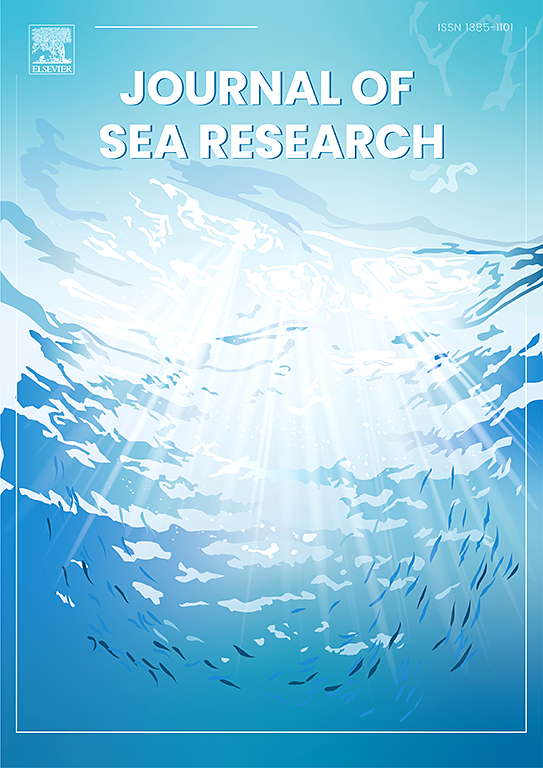两种灯笼鱼(Gymnoscopelus bolini和lepidophhanes guentheri)的营养生态学分析表明,西南大西洋存在空间生态位分离
IF 2.9
4区 地球科学
Q2 MARINE & FRESHWATER BIOLOGY
引用次数: 0
摘要
嗜酸性粒细胞在中上层食物网中起着至关重要的作用,将基础营养水平与高阶消费者联系起来。尽管它们的生态重要性和高丰度,但这些鱼类的摄食习性尚未在亚热带大西洋西南部得到充分调查。研究了两种灯笼鱼(Gymnoscopelus bolini和Lepidophanes guentheri)营养生态学的空间变异。这些分析是基于受不同海洋学制度影响的西南亚热带大西洋的两个不同区域:(a)北部(20-28°S)和(b)南部(28-34°S)。胃内容物分析(SCA)显示,bolini主要捕食黄足类和桡足类(%FO: 18.2), L. guentheri主要捕食黄足类(%FO: 10.3)和毛纲(%FO: 3.4)。稳定同位素分析(SIA)结果表明,北方地区的L. guentheri具有不同的碳(δ13C)和氮(δ15N)平均值(±SD) (δ13C:−19.9±0.3‰;δ15 n: 6.2±0.9‰)和南部(δ13 c:−20.5±0.7‰;δ15N为8.5±2.3‰),而G. bolini(仅南部)的δ13C平均值为−20.4±0.6‰,δ15N为9.6±2.1‰。在南部地区,G. bolini和L. guentheri的饮食相似,同位素生态位重叠也很大(达92.9%)。北部和南部地区对谷氏乳杆菌的饲料偏好存在差异,δ13C和δ15N值差异显著(p = 0.002)。G. bolini和L. guentheri表现出通才的浮游动物食性行为。此外,区域似乎是一个决定性的因素,在营养生态学的孢子。我们假设区域影响主要是由于不同的海洋过程,影响初级生产力和营养链的基础。本文章由计算机程序翻译,如有差异,请以英文原文为准。
Trophic ecology analysis of two lanternfish species (Gymnoscopelus bolini and Lepidophanes guentheri) suggests spatial niche segregation in the southwestern Atlantic Ocean
Myctophids play a vital role in pelagic food webs by connecting basal trophic levels to higher-order consumers. Despite their ecological importance and high abundance, the feeding habits of these fishes have not yet been fully investigated in the Southwest Subtropical Atlantic. We examined spatial variations in the trophic ecology of two lanternfish (Myctophidae: Myctophiformes) species (Gymnoscopelus bolini and Lepidophanes guentheri). The analyses were based on two different regions of the southwest subtropical Atlantic influenced by distinct oceanographic regimes: (a) the north (20–28°S) and (b) south (28–34°S). Stomach content analysis (SCA) revealed that G. bolini preyed mainly on Euphausia spp. and Copepoda (%FO: 18.2), and L. guentheri preyed mainly on Euphausia spp. (%FO: 10.3) and Chaetognatha (%FO: 3.4). Stable isotope analysis (SIA) revealed that L. guentheri had different mean carbon (δ13C) and nitrogen (δ15N) values (± SD) between the north (δ13C: −19.9 ± 0.3 ‰; δ15N: 6.2 ± 0.9 ‰) and south (δ13C: −20.5 ± 0.7 ‰; δ15N: 8.5 ± 2.3 ‰) regions, while G. bolini (south only) had average values of δ13C: −20.4 ± 0.6 ‰, δ15N: 9.6 ± 2.1 ‰. In the southern region, there was similarity between the diets of G. bolini and L. guentheri, and the isotopic niche overlap was also considerable (up to 92.9 %). When comparing the northern and southern regions, there were dietary differences for L. guentheri, as well as significant differences in δ13C and δ15N values (p = 0.002). G. bolini and L. guentheri exhibited a generalist zooplanktivorous feeding behaviour. In addition, region seems to be a determining factor in the trophic ecology of Myctophidae. We hypothesized that the region influence is mainly due to the distinct oceanographic processes that affect primary productivity and the base of the trophic chain.
求助全文
通过发布文献求助,成功后即可免费获取论文全文。
去求助
来源期刊

Journal of Sea Research
地学-海洋学
CiteScore
3.20
自引率
5.00%
发文量
86
审稿时长
6-12 weeks
期刊介绍:
The Journal of Sea Research is an international and multidisciplinary periodical on marine research, with an emphasis on the functioning of marine ecosystems in coastal and shelf seas, including intertidal, estuarine and brackish environments. As several subdisciplines add to this aim, manuscripts are welcome from the fields of marine biology, marine chemistry, marine sedimentology and physical oceanography, provided they add to the understanding of ecosystem processes.
 求助内容:
求助内容: 应助结果提醒方式:
应助结果提醒方式:


